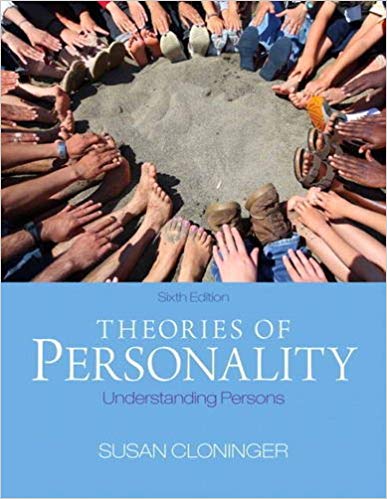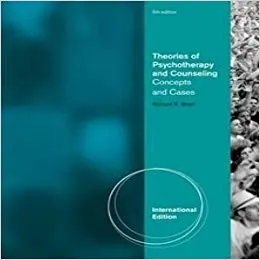Description
Test Bank For Theories of Personality Understanding Persons 6th Edition By Susan C. Cloninger
Theories of Personality, 6e (Cloninger)
Chapter 3
Multiple Choice
1) The fact that Martin Luther King, Jr. expressed himself within the Christian symbols of his own
heritage, rather than using symbols from other religious traditions,
A) would have been a disappointment to Jung.
B) was consistent with Jung’s advice that people stay within the symbols and mythology of their own
heritage.
C) was evidence that he had not developed to his full potential.
D) shows that he was prejudiced.
Answer: B
Difficulty: 2, p. 45
Question Type: Conceptual
2) According to the text, Dr. Martin Luther King, Jr., spoke in symbolic terms of the future potentials of
the world because he was
A) a minister.
B) an intuitive type.
C) black.
D) an extravert.
Answer: B
Difficulty: 2, p. 45
Question Type: Factual
3) Compared to Freud, Jung’s theory is
A) highly deterministic.
B) mystical.
C) less concerned with heredity.
D) more concerned with early childhood experience.
Answer: B
Difficulty: 2, p. 46
Question Type: Factual
4) What was Jung’s attitude toward scientific methods and language?
A) He praised scientific methods above literary methods.
B) He rejected science, saying it is unsuitable for understanding the psyche.
C) He accepted experimental science, but not survey methods.
D) He agreed with Freud’s opinion about science.
Answer: B
Difficulty: 2, p. 46
Question Type: Factual
5) When Jung and Freud first met
A) they argued, and decided they could not be colleagues.
B) they had much to talk about (13 hours worth!).
C) they planned to set up a joint therapy clinic.
D) Jung asked to be Freud’s patient.
Answer: B
Difficulty: 2, p. 47
Question Type: Factual
6) Jung’s term, “Self,” refers to
A) conscious self-concept.
B) how people are perceived by others.
C) the total, integrated personality.
D) unhealthy narcissism.
Answer: C
Difficulty: 3, p. 48
Question Type: Conceptual
7) Jung refers to the total, integrated personality as
A) the Self.
B) the persona.
C) the Great Mother.
D) the animus.
Answer: A
Difficulty: 2, p. 48
Question Type: Factual
8) According to Jung, the relationship between the conscious and unconscious aspects of personality is
best understood as
A) inflation.
B) conflict.
C) repression.
D) compensation.
Answer: D
Difficulty: 2, p. 48
Question Type: Conceptual
9) The adult developmental process in which various aspects of the unconscious are explored is called
A) individuation.
B) ego inflation.
C) teleology.
D) mysticism.
Answer: A
Difficulty: 2, pp. 48 – 49
Question Type: Factual
10) Individuation is the process of
A) finding a social identity.
B) finding the one individual who will be a life-long love partner.
C) re-centering in adult development.
D) discovering one’s major personality traits.
Answer: C
Difficulty: 3, pp. 48 – 49
Question Type: Factual
11) In mid-life development, diverse aspects of the psyche are integrated through the
A) anima.
B) persona.
C) transcendent function.
D) dominant function.
Answer: C
Difficulty: 3, pp. 48 – 49
Question Type: Factual
12) Jung described the ego as
A) the gatekeeper to consciousness.
B) the center of will.
C) the most conscious aspect of personality.
D) all of the above.
Answer: D
Difficulty: 2, p. 49
Question Type: Factual
13) Jung suggested that the center of personality ought to be
A) in the conscious aspects of personality.
B) in the unconscious aspects of personality.
C) balanced between the conscious and unconscious aspects of personality.
D) outside of personality.
Answer: C
Difficulty: 3, p. 49
Question Type: Conceptual
14) The persona is the aspect of personality that
A) adapts to the world.
B) is the basis for the true Self.
C) deceives others.
D) contains the sexual and aggressive instincts.
Answer: A
Difficulty: 2, p. 49
Question Type: Factual
15) Neglected and repressed aspects of personality that are inconsistent with a person’s self-concept are
found in
A) the ego.
B) the shadow.
C) the persona.
D) the dominant function.
Answer: B
Difficulty: 2, p. 49
Question Type: Factual
16) According to Jung, the shadow
A) often contains sexual impulses.
B) often contains aggressive impulses.
C) is the gatekeeper to the unconscious.
D) all of the above.
Answer: D
Difficulty: 2, p. 50
Question Type: Conceptual
17) According to Jung, prejudice against racial minorities involves projection of the
A) anima.
B) animus.
C) shadow.
D) dominant function.
Answer: C
Difficulty: 2, p. 50
Question Type: Conceptual
18) Men’s “inner woman” is described by Jung’s concept of the
A) anima.
B) animus.
C) shadow.
D) Great Mother.
Answer: A
Difficulty: 2, p. 50
Question Type: Factual
19) Jungian theory suggests that a woman who is seeking her “Prince Charming” is, in fact, really looking
for her
A) anima.
B) animus.
C) shadow.
D) persona.
Answer: B
Difficulty: 2, p. 50
Question Type: Conceptual
20) Jung felt that men fell in love with women on whom they projected their
A) anima.
B) animus.
C) persona.
D) shadow.
Answer: A
Difficulty: 2, pp. 50 – 51
Question Type: Conceptual
21) Which of the following is/are part of the personal unconscious?
A) the anima
B) the animus
C) the shadow
D) all of the above
Answer: D
Difficulty: 2, p. 51
Question Type: Factual
22) The collective unconscious contains
A) fixations.
B) complexes.
C) the Self.
D) archetypes.
Answer: D
Difficulty: 2, p. 51
Question Type: Factual
23) The collective unconscious
A) is determined by heredity, rather than experience.
B) contains archetypes.
C) is a mystical concept.
D) all of the above
Answer: D
Difficulty: 2, p. 51
Question Type: Factual
24) Jung’s concept of the “collective unconscious” is controversial because
A) it is difficult to operationally define.
B) it suggests that personality is inherited, thus contributing to racism.
C) it is contrary to the environmental emphasis of most of psychology.
D) all of the above.
Answer: D
Difficulty: 3, p. 51
Question Type: Conceptual
25) The archetypes that are closest to consciousness are
A) the Great Mother and the Spiritual Father.
B) the Hero and the Trickster.
C) the Mandala and the Self.
D) the Shadow and the Anima (or Animus).
Answer: D
Difficulty: 3, pp. 51 – 52
Question Type: Conceptual





Be the first to review “Test Bank For Theories of Personality Understanding Persons 6th Edition By Susan C. Cloninger”